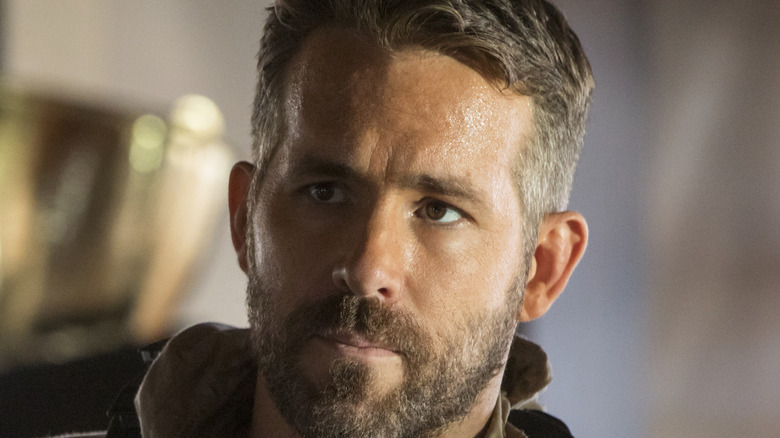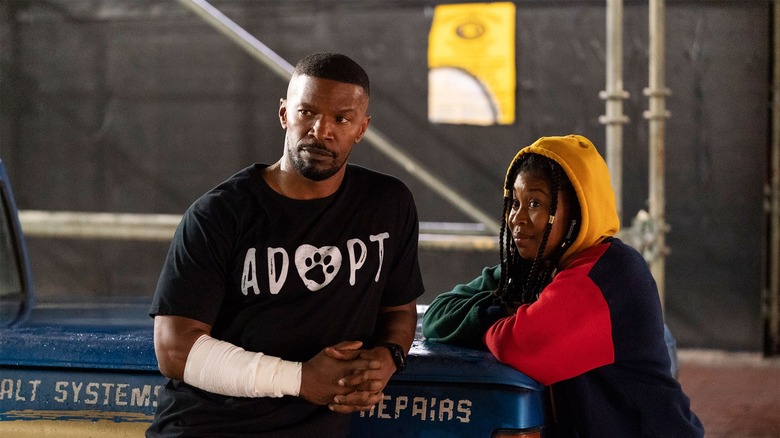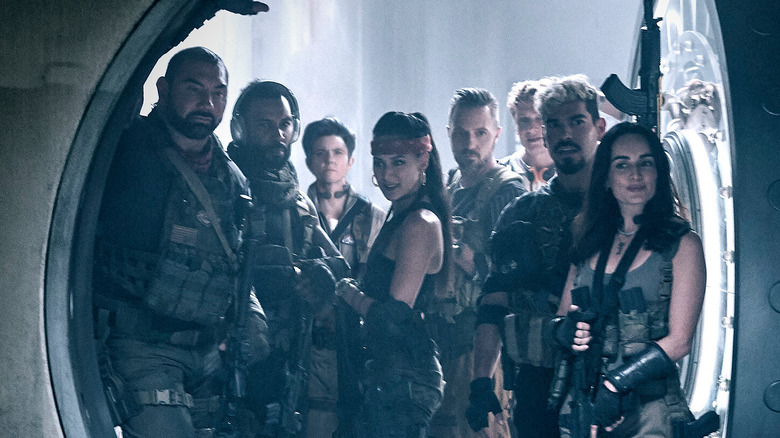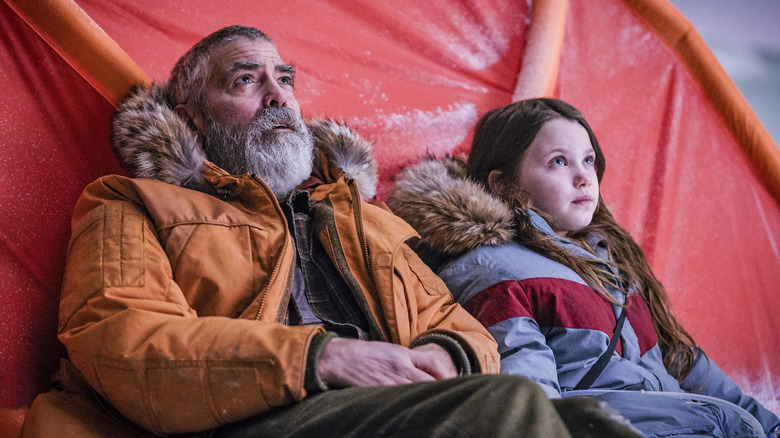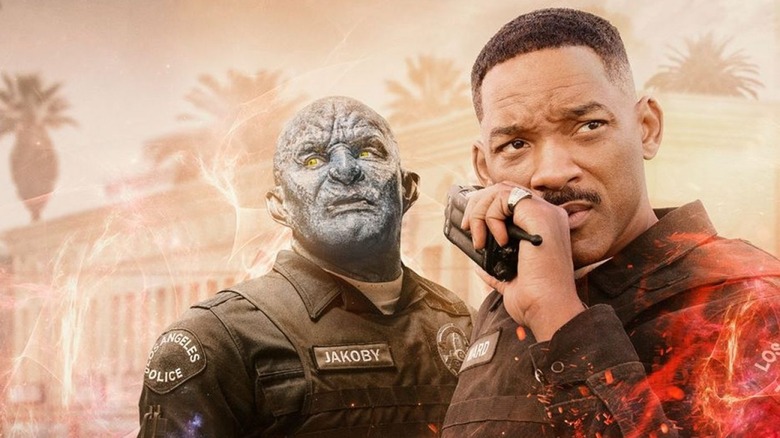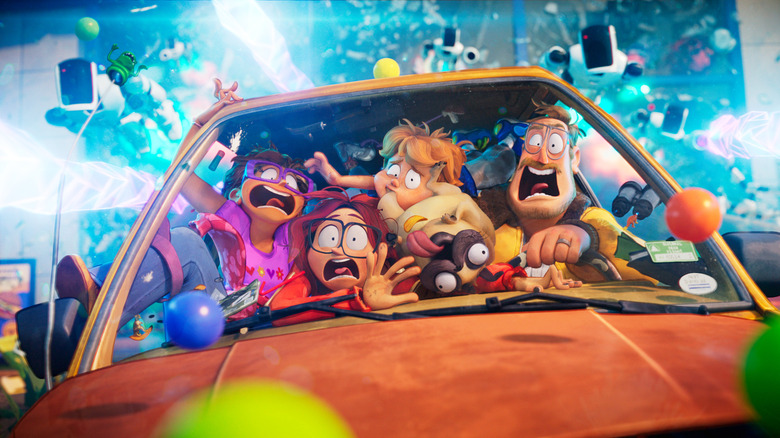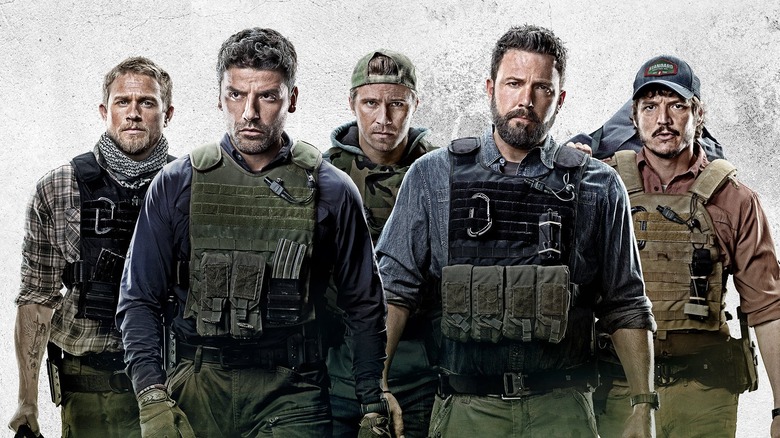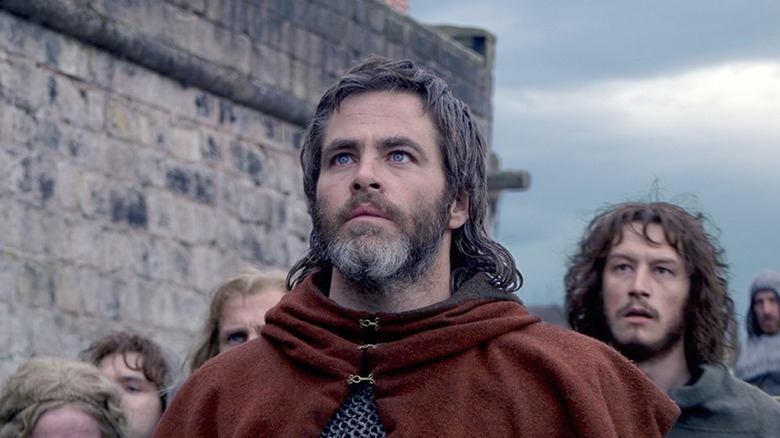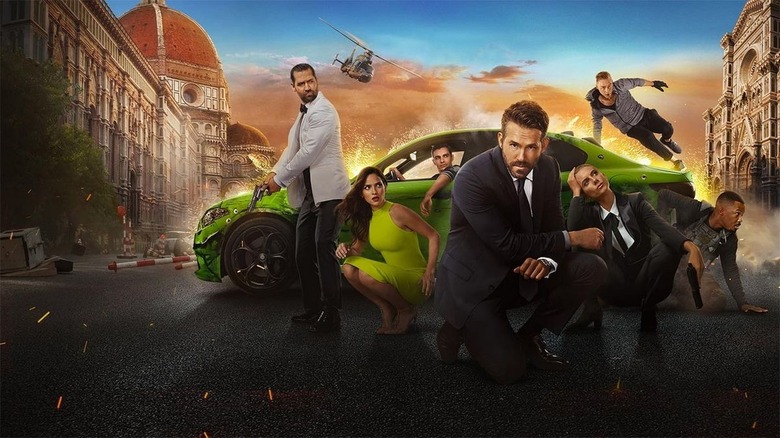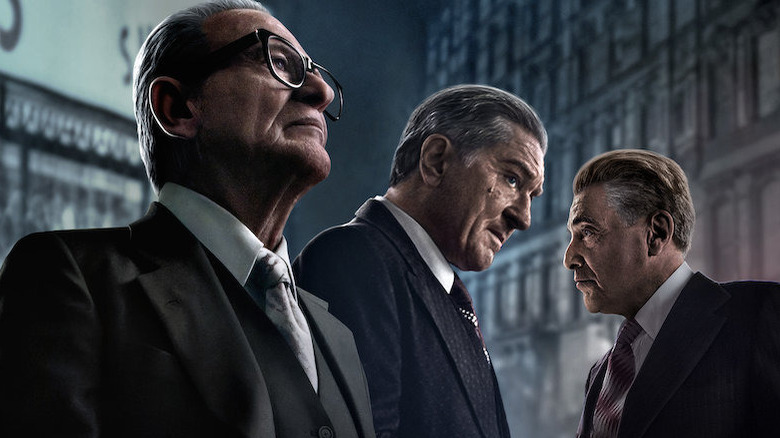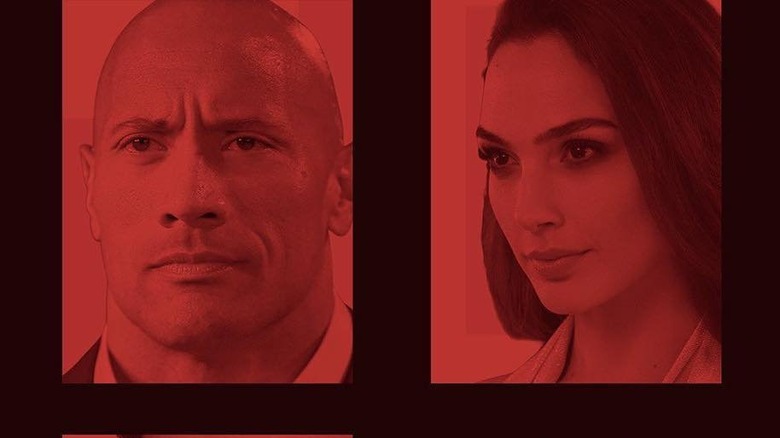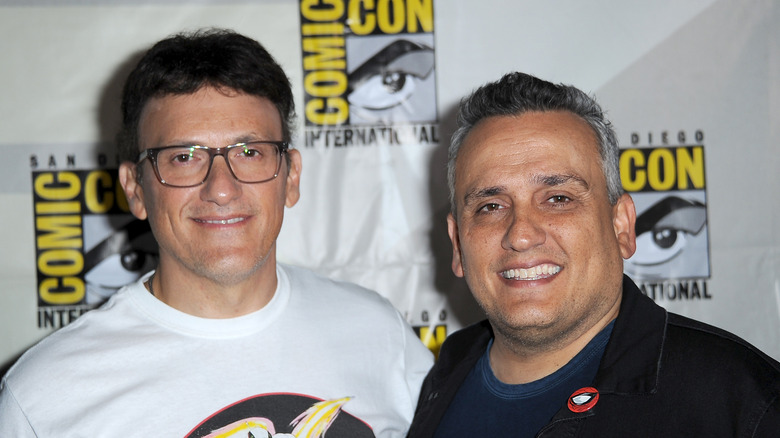These Are The Most Expensive Netflix Original Movies Of All Time
There was a time when movies made to bypass theatrical release were inherently cheap affairs. You had made-for-TV movies (typically airing on the major broadcast networks, starring past-their-prime names like Farrah Fawcett or James Garner), straight-to-video (even lower budgets, starring names like Frank Stallone and Kari Wuhrer), and the occasional basic cable exploitation flick with Meredith Baxter.
Those days have since vanished, replaced instead by on-demand, original movies made by virtually every channel on the dial and most significantly, streaming. This influx of services looks to lure viewers with high-profile filmmaking, and leading the charge for much of the streaming era has been Netflix — which has never been afraid of spending a lot of coin to get big-name artists like Adam Sandler or Kevin Hart to work on their original movies.
Netflix's willingness to spend boatloads of cash to create exclusive movies is apparent through both their production scope and the big-name actors that often come with them. Looking back to 2014 — when Netflix revealed their groundbreaking $275 million production deal with Sandler, announcing with authority they would begin making films — below are the most expensive Netflix movies of all time.
Project Power
Movies with super-powered people don't come cheap. Just ask the folks at Marvel Studios, who have produced 23 movies that have all cost upwards of $140 million.
It makes sense, then, that Netflix's "Project Power," the story of pills that give people brief bursts of superpowers, had an $85.1 million price-tag. All that moolah was used to ensure the project could employ lavish visual effects to depict those superpowers in the film, most of which was shot in New Orleans. That budget also helped lure in major stars like Joseph Gordon-Levitt and Oscar-winner Jamie Foxx.
The scope of "Power" was something new for directors Henry Joost and Ariel Schulman, best known for directing the ultra-low-budget documentary "Catfish," then taking a small-ish step up with the still-modestly-budgeted studio horror films "Paranormal Activity 3" and "Paranormal Activity 4." Like everything else on this list, it's quite difficult to say whether the film made its money back, because Netflix famously withholds its ratings numbers from the public. But from an anecdotal point of view, perhaps you might ask yourself whether you or anyone else you know has ever heard of the film, which came out in August 2020.
Army of the Dead
In some cases, a filmmaker shifting over to Netflix means they'll be working with a larger budget than they are accustomed to, but the May 21 release "Army of the Dead" actually seems like a step backwards for director Zack Snyder, who likely worked with much bigger budgets for films like "Justice League," "Man of Steel," "Watchmen" and more.
"Army of the Dead" ended up costing $90 million to make, which is actually impressive considering the scope of its story. Starring Dave Bautista (from the "Guardians of the Galaxy" movies), "Dead" tells the tale of a post-zombie-apocalypse world where Las Vegas has been compromised, with all the zombies trapped there. Bautista and a team of mercenaries take on a mission to head into the city and steal $50 million from a vault — before the government drops a nuke on Vegas.
All those zombies, living-dead tigers and horses, and an impressively re-created Vegas strip would seem to cost a few bucks. But the film does utilize character actors rather than big-name stars, and zombies are cheaper to realize than, say, alien spaceships laying waste to Metropolis. But to put it another way, the price of brain-eating has definitely gone up: The $90 million cost of "Army of the Dead" is substantially higher than the $28 million budget of Snyder's first zombie flick, 2004's "Dawn of the Dead."
The Midnight Sky
Before "The Midnight Sky," George Clooney's most expensive directorial effort was the $70 million budgeted "The Monuments Men." That 2014 film was a box-office disappointment, so it seems perhaps inadvisable that Netflix would give him a $100 million budget for "Sky," a post-apocalyptic story about a scientist in the Arctic, but they did.
Co-starring Felicity Jones, Kyle Chandler and David Oyelowo, the film came out in December of 2020 and was almost immediately labeled a dud. Currently on Rotten Tomatoes, critics have given it a 50% while audiences have ranked the film even lower at 26%.
The sizable budget of "Sky" and its accompanying spectacle did, however, allow it to be a contender in the technical categories at the 93rd Academy Awards. Clooney seems to be putting his feet back on the ground post-"Midnight Sky" — his next directorial effort is called "The Tender Bar" and seems to be about barflys rather than space dangers.
Bright
"Bright" was a breakthrough movie for Netflix, and will quite possibly be remembered as the first time a Netflix Original drew buzz that drowned out many of its rival theatrical releases.
The studio's first time getting into the realm of big-budget blockbusters, Netflix beat out the likes of Warner Bros. and Columbia Pictures for the bidding rights to "Bright," giving the film a massive $106.2 million budget to ensure it would look as good as anything on the big screen. Having Will Smith as a star furthered that pedigree, even if the budget wasn't quite what something like "Hancock" or "I Am legend" would cost to produce.
For comparison's sake, "The Ridiculous Six," a 2015 Adam Sandler Western, cost $60 million, a budget that "Bright" would nearly double. All that money was needed, though, to realize the modern fantasy world of "Bright" — and it paid off, because when the film debuted in December of 2017 it became something of a phenomenon. Sure, some on social media were mocking the mismatched-cops-turned-different-species gimmick, but others praised the film, and there has occasionally been talk of a sequel.
The Mitchells vs. The Machines
Netflix has made no secret of how badly it wants to become a dominant force in the world of kid-friendly animation. Not only has Netflix Animation struck several deals with high-profile animators to produce projects for the studio, but there are also plans in place for Netflix to produce as many as six animated films a year.
As part of these efforts, Netflix has kept its eyes peeled for potential high-profile animated films it could acquire and then debut on its service. After all, it doesn't matter if the titles are initially developed outside Netflix — what matters is that they premiere and remain exclusive to the streamer.
This is where "The Mitchells vs. The Machines" enters the equation. Hailing from red-hot producers Phil Lord & Chris Miller ("Spider-Man: Into the Spider-Verse"), the animated film about a dysfunctional family saving civilization from a robot uprising was originally produced by Sony Pictures Animation for a Fall 2020 theatrical release.
Like so many other 2020 titles, COVID-19 put those plans on ice — but Netflix stepped up to shell out $110 million for worldwide distribution rights (save for China) to the animated comedy. It might not have come cheap, but as a result of putting down all this money, Netflix added one of 2021's biggest animated movies to its slate of releases, and it has become one of Netflix's best-reviewed movies of all-time, animated or otherwise.
Triple Frontier
When "Triple Frontier" debuted in March 2019, it got a decent critical reception before largely fading out of the pop culture consciousness. However, it came roaring back after a July 2019 IndieWire piece revealed what exactly the budget of the production was. Unbeknownst to people, "Triple Frontier" had cost $115 million to make, a budget that apparently kept on climbing as the film was shot.
The budget was a shock to many, for multiple reasons. For starters, "Triple Frontier" wasn't the kind of movie one associates with a $115 million budget, since it has no big CGI robots or particularly enormous action scenes. For another, director J.C. Chandor had cut his teeth on low-budget indies like "Margin Call" and "All Is Lost," not exactly establishing himself as the type of filmmaker studios would typically bankroll on that level.
But expensive projects can hide in plain sight, and the existence of the costly "Triple Frontier" (which was filmed in Hawaii and starred names like Ben Affleck, Oscar Isaac and Pedro Pascal, none of which screams cost-cutting measure) shows how Netflix's commitment to exchanging big-budget body blows with the studios can be seen across all genres.
Outlaw King
In the wake of "Gladiator," Hollywood had a reignited love affair with period-piece epics. But when Oliver Stone's 2004 bomb "Alexander" proved that making the next "Gladiator" was harder than it appeared, these movies seemed to go back on the shelf as a relic of Hollywood's past.
Leave it to Netflix, however, to try and revive the genre on multiple occasions, including the 2018 Chris Pine movie "Outlaw King." At the time the most expensive movie ever released by Netflix, "Outlaw King" carried a gigantic price tag of $120 million.
All that money was necessary to tell this period-era story about the 14th century Scottish rebel Robert the Bruce, who defeated the occupying English army by employing his wit and courage. Of course, Scottish settings, giant castles, costumes and sets don't come cheap, and director David MacKenzie was devoted to capturing the era correctly.
Netflix was likely fine with spending all this money considering how often grand epics like "Outlaw King" managed to score high-profile Oscar nods, and we have seen the streamer over the last few years doing everything it can to capture Oscars. Ultimately, "Outlaw King" was a no-show come awards season, and combined with a mixed critical reception, it faded from memory very quickly.
6 Underground
Michael Bay doesn't always require a massive budget to make one of his movies — after all, he did make the $26 million budgeted "Pain & Gain." But he does require a massive budget pretty much every single other time, the kind that exceed some nation's budgets and yield explosions powerful enough to topple buildings. So, it makes sense that the man behind the live-action "Transformers" movies would need $150 million to make his first movie with Netflix, entitled "6 Underground."
An ensemble action film headlined by Ryan Reynolds, a large part of the film's budget apparently went to Reynolds, which makes sense because he's one of Hollywood's most in-demand stars. The film was also shot in exotic locales all over the world and occupied by seemingly non-stop onslaught of slow-motion, explosions, over-the-top dialogue and other hallmarks of a Michael Bay movie.
Telling the tale of an enigmatic billionaire who funds his own black ops strike team, even the detractors of "Six Underground" would be the first to admit that the movie certainly looks like it cost $150 million to create. So, it can't be said that Netflix didn't get its money's worth.
The Irishman
Scorsese. De Niro. Pacino. Pesce.
Such names are legends, and legends don't come cheap. Neither do the special effects needed to make these elderly actors look like they did when they were half their age — or even younger.
For "The Irishman," Martin Scorsese required a $159 million budget, a necessary cost due to how the film would be using digital technology to alter the ages of actors like Robert De Niro and Al Pacino. Initially, Scorsese had secured the money from various movie studios such as STX International and Paramount Pictures. However, after Paramount backed off, "The Irishman" appeared to be in jeopardy.
That's where Netflix came in. This studio had significant interest, primarily because a new Scorsese movie could give them huge prestige come awards season. Sure enough, when the film based on Charles Brandt's book "I Heard You Paint Houses" arrived on Netflix in November 2019 it immediately became one of the most talked about films of the year, earned universal acclaim, and snagged 10 Oscar nominations including the coveted Best Picture — although, it didn't win any of them.
"The Irishman" is also a great example of Netflix owning an asset that should pay dividends for decades. If film lovers are still devouring the "Godfather" movies, "Goodfellas," "Scarface" and "Heat" all these years later, who is to say their grandkids won't still be watching and re-watching "The Irishman"?
Red Notice
For just a moment, it appeared that "Red Notice" was dead in the water. Despite starring both Dwayne Johnson and Gal Gadot, the film had been paused by Universal due to the budget escalating to a steep degree. Luckily for those involved, Netflix had no such qualms about spending big on a new, original blockbuster starring the man many consider to be the biggest movie star in the world. So, Netflix scooped up "Red Notice" and blessed it with a massive $200 million budget.
For a theatrical release, that kind of budget wouldn't make much sense. After all, none of Johnson's non-"Fast & Furious" movies have made anywhere near enough at the worldwide box office to justify a $200 million price-tag, save for the two "Jumanii" titles, which similarly had some sort of name recognition to boost the franchise.
But for Netflix, the goal is never to turn a profit on worldwide box office. Spending $200 million on a title like "Red Notice" ensured that Netflix subscribers would continue to receive a steady flow of buzzy, star-studded movies to watch that they couldn't get anywhere else. Thus, one studio's dismissal is another streamer's blockbuster — especially when that blockbuster stars a slew of famous faces.
The Gray Man
Where would Anthony and Joe Russo go after during "Avengers: Endgame?" Following up the highest grossing movie of all-time can be pretty daunting.
The answer seems to be in major streaming titles. After following up that blockbuster with the poorly-reviewed Apple+ release "Cherry," the directorial duo are next embarking on the action blockbuster "The Gray Man" with Netflix.
The project returns The Russo Brothers to familiar territory in more ways than one. Not only does it plant them firmly back into big-budget blockbuster territory, but it also features a number of actors that have appeared in their prior directorial efforts, from Chris Evans to Michael Gandolfini to Alfre Woodard.
Headlined by Ryan Gosling, the globe-trotting thriller is not being made on the cheap, with reports that it will cost north of $200 million to produce. Of course, all but one of the Marvel Cinematic Universe movies helmed by the Russo Brothers cost at least that much to make, so handling a movie of this scope isn't a new challenge for the filmmakers.
However, crossing the $200 million threshold is not a regularly-occurring thing for Netflix yet, so clearly they have a lot of faith in the project.
Where does Netflix go from here? If the service keeps thriving, perhaps $200 million productions could become commonplace, and their Netflix Originals budgets will only continue to soar. Either way, this much seems clear: The next blockbuster you want to see seems as likely to premiere at theaters nationwide as it does in your living room.
